Physicochemical and Storage Characteristics of Pork Tteokgalbi Treated with Watermelon Radish Powder
Abstract
1. Introduction
2. Materials and Methods
2.1. Preparation of Watermelon Radish Powder from the Flesh
2.2. Analysis of the Fatty Acid Composition of n-3-Enhanced Pork
2.3. Recipe of Tteokgalbi Treated with Watermelon Radish Powder
2.4. Antioxidative Properties and Proximate Compositions of Watermelon Radish Powder-Treated Tteokgalbi
2.5. Water-Holding Capacity (WHC) and Cooking Loss of Tteokgalbi
2.6. Color of Tteokgalbi before and after Cooking
2.7. Texture-Profile Analysis (TPA) of Tteokgalbi
2.8. Storage Characteristics of Tteokgalbi
2.9. Statistical Analysis
3. Results and Discussion
3.1. Fatty Acid Composition of n-3-Enhanced Pork
3.2. Proximate Composition of Tteokgalbi
3.3. WHC and Cooking Loss
3.4. Chromaticity of Tteokgalbi before and after Cooking
3.5. Textural Properties of Tteokgalbi
3.6. Antioxidative Properties
3.7. Storage Characteristics
4. Conclusions
Author Contributions
Funding
Institutional Review Board Statement
Informed Consent Statement
Data Availability Statement
Conflicts of Interest
References
- Byeon, Y.-S.; Kim, H.-Y. Antioxidative Characteristics of Dried Type Sodium Reduced Chicken Bibimbap Using Dandelion Complex Extract Powder of AF-343 as a Home Meal Replacement. Korean J. Food Cook. Sci. 2015, 31, 378–386. [Google Scholar] [CrossRef]
- Choi, J. Impact of Social Risk by COVID-19 on Consumption Psychology and Consumption Behavior; Yonsei University: Seoul, Korea, 2020. [Google Scholar]
- Zoumpourlis, V.; Goulielmaki, M.; Rizos, E.; Baliou, S.; Spandidos, D.A. The COVID-19 Pandemic as a Scientific and Social Challenge in the 21st Century. Mol. Med. Rep. 2020, 22, 3035–3048. [Google Scholar] [CrossRef] [PubMed]
- Kim, H.; Park, D.H.; Geun-PyoLee, S.-Y.; Choi, M.J.; Cho, Y. The Change in Quality Characteristics of Hanwoo in Home Meal Replacement Products under Different Cooking and Freezing Methods. Korean J. Food Sci. Anim. Resour. 2018, 38, 180–188. [Google Scholar] [PubMed]
- Lee, J.; Choi, J.; Ha, J. Physicochemical and Storage Characteristics of Pork Tteokgalbi Treated with Boesenbergia pandurata (Roxb.) Powder. Appl. Sci. 2022, 12, 2425. [Google Scholar] [CrossRef]
- Son, H.K.; Xiang, H.; Park, S.; Lee, J.; Lee, J.J.; Jung, S.; Ha, J.H. Partial Replacement of Dietary Fat with Polyunsaturated Fatty Acids Attenuates the Lipopolysaccharide-Induced Hepatic Inflammation in Sprague-Dawley Rats Fed a High-Fat Diet. Int. J. Environ. Res. Public Health 2021, 18, 10986. [Google Scholar] [CrossRef]
- Son, H.K.; Kim, B.H.; Lee, J.; Park, S.; Oh, C.B.; Jung, S.; Lee, J.K.; Ha, J.H. Partial Replacement of Dietary Fat with Krill Oil or Coconut Oil Alleviates Dyslipidemia by Partly Modulating Lipid Metabolism in Lipopolysaccharide-Injected Rats on a High-Fat Diet. Int. J. Environ. Res. Public Health 2022, 19, 843. [Google Scholar] [CrossRef]
- Lee, J.; Lee, J.K.; Lee, J.J.; Park, S.; Jung, S.; Lee, H.J.; Ha, J.H. Partial Replacement of High-Fat Diet with Beef Tallow Attenuates Dyslipidemia and Endoplasmic Reticulum Stress In db/db Mice. J. Med. Food. 2022, 25, 660–674. [Google Scholar] [CrossRef]
- Park, S.; Lee, J.J.; Lee, J.; Lee, J.K.; Byun, J.; Kim, I.; Ha, J.H. Lowering n-6/n-3 Ratio as an Important Dietary Intervention to Prevent LPS-Inducible Dyslipidemia and Hepatic Abnormalities in Ob/Ob Mice. Int. J. Mol. Sci. 2022, 23, 6384. [Google Scholar] [CrossRef] [PubMed]
- Raederstorff, D.; Wyss, A.; Calder, P.C.; Weber, P.; Eggersdorfer, M. Vitamin E Function and Requirements in Relation to PUFA. Br. J. Nutr. 2015, 114, 1113–1122. [Google Scholar] [CrossRef]
- Ha, J.H.; Shil, P.K.; Zhu, P.; Gu, L.; Li, Q.; Chung, S. Ocular Inflammation and Endoplasmic Reticulum Stress Are Attenuated by Supplementation with Grape Polyphenols in Human Retinal Pigmented Epithelium Cells and in C57BL/6 Mice. J. Nutr. 2014, 144, 799–806. [Google Scholar] [CrossRef]
- Hong, S.C.; Ha, J.H.; Lee, J.K.; Jung, S.H.; Kim, J.C. In Vivo Anti-Inflammation Potential of Aster Koraiensis Extract for Dry Eye Syndrome by the Protection of Ocular Surface. Nutrients 2020, 12, 3245. [Google Scholar] [CrossRef] [PubMed]
- Ha, J.H.; Lee, J.H.; Lee, J.J.; Choi, Y.I.; Lee, H.J. Effects of Whey Protein Injection as a Curing Solution on Chicken Breast Meat. Food Sci. Anim. Resour. 2019, 39, 494–502. [Google Scholar] [CrossRef] [PubMed]
- Bae, I.K.; Kim, K.J.; Choi, J.S.; Choi, Y.I.; Ha, J.H. Quality Properties and Storage Characteristics of Pyeonyuk with Different Additional Levels of Turmeric Powder. Food Sci. Anim. Resour. 2019, 39, 35–44. [Google Scholar] [CrossRef] [PubMed]
- Jae-Joon, L.; Eun, J.; Yeon-Jin, P. Quality Characteristics and Antioxidant Activity of Yanggaeng Added with Watermelon Radish Flesh Powder. Korean J. Food Nutr. 2021, 34, 631–640. [Google Scholar]
- Song, Y.-B.; Choi, J.-S.; Lee, J.-E.; Noh, J.-S.; Kim, M.-J.; Cho, E.-J.; Song, Y.-O. The Antioxidant Effect of Hot Water Extract from the Dried Radish (Raphanus sativus L.) with Pressurized Roasting. J. Korean Soc. Food Sci. Nutr. 2010, 39, 1179–1186. [Google Scholar] [CrossRef]
- Jeon, H.; Kim, H.; Song, Y. Effect of Kimchi Solvent Fractions on Anti-oxidative Enzyme Activities of Heart, Kidney and Lung of Rabbit Fed a High Cholesterol Diet. J. Korean Soceity Food Sci. Nutr. 2003, 32, 250–255. [Google Scholar]
- Kim, H.-K. The Effects of Reducing Skin Wrinkles and Improving Skin Elasticity from Korean Radish Extract. Int. J. Adv. Smart Converg. 2019, 8, 113–125. [Google Scholar]
- Banihani, S.A. Radish (Raphanus sativus) and Diabetes. Nutrients 2017, 9, 1014. [Google Scholar] [CrossRef]
- Sim, W.-S.; Choi, S.-I.; Cho, B.-Y.; Choi, S.-H.; Han, X.; Cho, H.-D.; Kim, S.-H.; Lee, B.-Y.; Kang, I.-J.; Cho, J.-H.; et al. Anti-obesity Effect of Extract from Nelumbo nucifera L., Morus Alba L., and Raphanus sativus Mixture in 3T3-L1 Adipocytes and C57BL/6J Obese Mice. Foods 2019, 8, 170. [Google Scholar] [CrossRef]
- Ahn, Y.-H.; Yoo, J.-S.; Kim, S.-H. An Antioxidant Capacity Assay Using a Polyvinyl Alcohol-Based DPPH Pellet. Bull. Korean Chem. Soc. 2010, 31, 2557–2560. [Google Scholar] [CrossRef]
- Song, H.S.; Bae, J.K.; Park, I. Effect of Heating on DPPH Radical Scavenging Activity of Meat Substitute. Prev. Nutr. Food Sci. 2013, 18, 80–84. [Google Scholar] [CrossRef][Green Version]
- Kang, J.; Lee, J.; Choi, M.; Jin, Y.; Chang, D.; Chang, Y.H.; Kim, M.; Jeong, Y.; Lee, Y. Physicochemical and Textural Properties of Noodles Prepared from Different Potato Varieties. Prev. Nutr. Food Sci. 2017, 22, 246–250. [Google Scholar] [CrossRef]
- Romans, J.R.; Johnson, R.C.; Wulf, D.M.; Libal, G.W.; Costello, W.J. Effects of ground flaxseed in swine diets on pig performance and on physical and sensory characteristics and omega-3 fatty acid content of pork: I. Dietary level of flaxseed. J. Anim. Sci. 1995, 73, 1982–1986. [Google Scholar] [CrossRef]
- Wang, P.; Xu, X.-L.; Zhou, G.-H. Effects of Meat and Phosphate Level on Water-Holding Capacity and Texture of Emulsion-Type Sausage during Storage. Agric. Sci. China 2009, 8, 1475–1481. [Google Scholar] [CrossRef]
- Huttunen, M.M.; Pietilä, P.E.; Viljakainen, H.T.; Lamberg-Allardt, C.J. Prolonged Increase in Dietary Phosphate Intake Alters Bone Mineralization in Adult Male Rats. J. Nutr. Biochem. 2006, 17, 479–484. [Google Scholar] [CrossRef] [PubMed]
- Meng, Y.; Sun, J.; Yu, J.; Wang, C.; Su, J. Dietary Intakes of Calcium, Iron, Magnesium, and Potassium Elements and the Risk of Colorectal Cancer: A Meta-analysis. Biol. Trace Elem. Res. 2019, 189, 325–335. [Google Scholar] [CrossRef]
- St-Jules, D.E.; Woolf, K.; Pompeii, M.L.; Kalantar-Zadeh, K.; Sevick, M.A. Reexamining the Phosphorus–Protein Dilemma: Does Phosphorus Restriction Compromise Protein Status? J. Ren. Nutr. 2016, 26, 136–140. [Google Scholar] [CrossRef] [PubMed]
- Ruusunen, M.; Vainionpää, J.; Puolanne, E.; Lyly, M.; Lähteenmäki, L.; Niemistö, M.; Ahvenainen, R. Physical and Sensory Properties of Low-Salt Phosphate-Free Frankfurters Composed with Various Ingredients. Meat Sci. 2003, 63, 9–16. [Google Scholar] [CrossRef]
- Zhu, Y.; Yan, Y.; Yu, Z.; Wu, T.; Bennett, L.E. Effects of High Pressure Processing on Microbial, Textural and Sensory Properties of Low-Salt Emulsified Beef Sausage. Food Control 2022, 133, 108596. [Google Scholar] [CrossRef]
- Jeon, M.-R.; Choi, S.-H. Quality Characteristics of Pork Patties Added with Seaweed Powder. Food Sci. Anim. Resour. 2012, 32, 77–83. [Google Scholar] [CrossRef]
- Choi, Y.-S.; Jeong, J.-Y.; Choi, J.-H.; Lee, M.; Lee, E.-S.; Kim, H.-Y.; Han, D.-J.; Kim, J.-M.; Kim, C.-J. Effects of Immersion Period after Tumbling Processing on the Quality Properties of Boiled Pork Loin with Soy Sauce. Korean J. Food Cook. Sci. 2006, 22, 379–385. [Google Scholar]
- Flores, M.; Moya, V.-J.; Aristoy, M.-C.; Toldrá, F. Nitrogen Compounds as Potential Biochemical Markers of Pork Meat Quality. Food Chem. 2000, 69, 371–377. [Google Scholar] [CrossRef]
- Winger, R.J.; Fennema, O. Tenderness and Water Holding Properties of Beef Muscle as Influenced by Freezing and Subsequent Storage at −3 or 15 °C. J. Food Sci. 1976, 41, 1433–1438. [Google Scholar] [CrossRef]
- Cheng, J.H.; Chen, Y.Q.; Sun, D.W. Effects of Plasma Activated Solution on the Colour and Structure of Metmyoglobin and Oxymyoglobin. Food Chem. 2021, 353, 129433. [Google Scholar] [CrossRef]
- Wang, X.; Wang, Z.; Zhuang, H.; Nasiru, M.M.; Yuan, Y.; Zhang, J.; Yan, W. Changes in Color, Myoglobin, and Lipid Oxidation in Beef Patties Treated by Dielectric Barrier Discharge Cold Plasma during Storage. Meat Sci. 2021, 176, 108456. [Google Scholar] [CrossRef]
- Asami, H.; Kawabata, R.; Kawauchi, N.; Kohno, J.-y. Photodissociation Spectroscopy of Hydrated Myoglobin Ions Isolated by IR-Laser Ablation of a Droplet Beam: Recovery from pH-Denatured Structure by Gas-Phase Isolation. Chem. Lett. 2019, 48, 140–143. [Google Scholar] [CrossRef]
- Krycki, M.M.; Lin, S.Y.; Loglio, G.; Michailov, A.V.; Miller, R.; Noskov, B.A. Impact of Denaturing Agents on Surface Properties of Myoglobin Solutions. Colloids Surf. B Biointerfaces 2021, 202, 111657. [Google Scholar] [CrossRef]
- Munsu, E.; Mohd Zaini, H.; Matanjun, P.; Ab Wahab, N.; Sulaiman, N.S.; Pindi, W. Physicochemical, Sensory Properties and Lipid Oxidation of Chicken Sausages Supplemented with Three Types of Seaweed. Appl. Sci. 2021, 11, 11347. [Google Scholar] [CrossRef]
- Gullón, B.; Gagaoua, M.; Barba, F.J.; Gullón, P.; Zhang, W.; Lorenzo, J.M. Seaweeds as Promising Resource of Bioactive Compounds: Overview of Novel Extraction Strategies and Design of Tailored Meat Products. Trends Food Sci. Technol. 2020, 100, 1–18. [Google Scholar] [CrossRef]
- Younis, K.; Yousuf, O.; Qadri, O.S.; Jahan, K.; Osama, K.; Islam, R.U. Incorporation of Soluble Dietary Fiber in Comminuted Meat Products: Special Emphasis on Changes in Textural Properties. Bioact. Carbohydr. Diet. Fibre 2022, 27, 100288. [Google Scholar] [CrossRef]
- Zhao, D.; Guo, C.; Liu, X.; Xiao, C. Effects of Insoluble Dietary Fiber from Kiwi Fruit Pomace on the Physicochemical Properties and Sensory Characteristics of Low-Fat Pork Meatballs. J. Food Sci. Technol. 2021, 58, 1524–1537. [Google Scholar] [CrossRef] [PubMed]
- Moghtadaei, M.; Soltanizadeh, N.; Goli, S.A.H. Production of Sesame Oil Oleogels Based on Beeswax and Application as Partial Substitutes of Animal Fat in Beef Burger. Food Res. Int. 2018, 108, 368–377. [Google Scholar] [CrossRef] [PubMed]
- Gómez-Estaca, J.; Pintado, T.; Jiménez-Colmenero, F.; Cofrades, S. Assessment of a Healthy Oil Combination Structured in Ethyl Cellulose and Beeswax Oleogels as Animal Fat Replacers in Low-Fat, PUFA-Enriched Pork Burgers. Food Bioprocess Technol. 2019, 12, 1068–1081. [Google Scholar] [CrossRef]
- Nahed, L.; Nasra, Z.; Hanaa, A.A.-E.; Abd El-Rahman, S. The Utilization of Yellow and Red Onion Peels and Their Extracts as Antioxidant and Antimicrobial in Preservation of Beef Burger during Storage. Am. J. Food Sci. Technol. 2022, 10, 1–9. [Google Scholar]
- Wang, T.; Jin, Y.; Yang, N.; Xu, D.; Yang, Z.; Tan, Y.; Xu, X.; Jin, Z.; Cui, B. Effect of Magnetic Field with Different Dimensions on Quality of Avocado Puree during Frozen Storage. Int. J. Food Sci. Technol. 2022, 57, 1698–1707. [Google Scholar] [CrossRef]
- Rahmasari, Y.; Yemiş, G.P. Characterization of Ginger Starch-Based Edible Films Incorporated with Coconut Shell Liquid Smoke by Ultrasound Treatment and Application for Ground Beef. Meat Sci. 2022, 188, 108799. [Google Scholar] [CrossRef]
- Ministry of Food and Drug Safety. Food Sanitation Act; Ministry of Food and Drug Safety: Cheongju, Korea, 2014.
- Swanson, K.M.J.; Buchanan, R.L.; Cole, M.B.; Cordier, J.L.; Flowers, R.S.; Gorris, L.G.M.; Taniwaki, M.H.; Tompkin, R.B.; Zwietering, M.H. Microorganisms in Foods: Use of Data for Assessing Process Control and Product Acceptance; Springer Science: Berlin/Heidelberg, Germany, 2011. [Google Scholar]
- MFDS. The Guideline of Processing and Composition Standard of Animal Resourced Food Products; Korean Food Drug Administration Notification No. 2014-135; MFDS: Cheongju, Korea, 2014. [Google Scholar]
| Item | Condition |
|---|---|
| Analytical instrument | GC-17A (Shimadzu, Japan) |
| Column | SP™-2560 capillary column (100 mm length × 0.25 mm inside diameter × 0.25 μm film thickness) |
| Detector | Flame ionization detector |
| Temperature | 170 °C (5 min) → 4 °C/min → 250 °C (30 min) |
| Analytical time | 80 min/sample |
| Ingredients | Treatments 1 (%) | ||||
|---|---|---|---|---|---|
| CON | REF | W1 | W2 | W3 | |
| Pork | 74.00 | 73.95 | 73.50 | 73.00 | 72.00 |
| Soy sauce | 2.20 | 2.20 | 2.20 | 2.20 | 2.20 |
| Tuna liquid | 0.50 | 0.50 | 0.50 | 0.50 | 0.50 |
| Salt | 0.60 | 0.60 | 0.60 | 0.60 | 0.60 |
| Garlic | 2.20 | 2.20 | 2.20 | 2.20 | 2.20 |
| Ginger | 0.40 | 0.40 | 0.40 | 0.40 | 0.40 |
| Onion | 3.70 | 3.70 | 3.70 | 3.70 | 3.70 |
| White sugar | 2.40 | 2.40 | 2.40 | 2.40 | 2.40 |
| Green onion | 3.60 | 3.60 | 3.60 | 3.60 | 3.60 |
| Honey | 3.00 | 3.00 | 3.00 | 3.00 | 3.00 |
| Apple juice | 3.70 | 3.70 | 3.70 | 3.70 | 3.70 |
| Black pepper | 0.20 | 0.20 | 0.20 | 0.20 | 0.20 |
| Sesame oil | 3.50 | 3.50 | 3.50 | 3.50 | 3.50 |
| Ascorbic acid | - | 0.05 | - | - | - |
| Watermelon radish powder (W) | - | - | 1.00 | 2.00 | 4.00 |
| Fatty Acid | % of Total Fatty Acids (g/100 g) |
|---|---|
| Caproic acid (C6:0) | 0.767 |
| Lauric acid (C12:0) | 0.253 |
| Myristic acid (C14:0) | 1.855 |
| Palmitic acid (C16:0) | 23.753 |
| Palmitoleic acid (C16:1) | 0.523 |
| Heptadecanoic acid (C17:0) | 0.229 |
| cis-10-Heptadecenoic acid (C17:1) | 0.229 |
| Stearic acid (C18:0) | 13.864 |
| Oleic acid (C18:1n-9c) | 31.992 |
| Linolelaidic acid (C18:2n-6ct) | 1.496 |
| Linoleic acid (C18:2n-6c) | 12.739 |
| α-Linolenic acid (C18:3n-3) | 1.908 |
| cis-11,14-Eicosatrienoic acid (C20:2) | 0.426 |
| cis-4,7,10,13,16,19-Docosahexaenoic acid (C22:6n-3) | 2.045 |
| n-3 fatty acid | 3.953 |
| n-6 fatty acid | 12.739 |
| n-6/n-3 ratio | 3.220 |
| Total fatty acids | 92.079 |
| Proximate Composition | Treatments 1 (Dry Weight Basis) | ||||
|---|---|---|---|---|---|
| CON | REF | W1 | W2 | W3 | |
| Moisture | 68.78 ± 0.11 2a | 67.99 ± 0.88 ab | 67.27 ± 0.52 ab | 66.26 ± 2.26 ab | 65.59 ± 0.79 b |
| Crude protein | 14.44 ± 0.11 a | 13.89 ± 0.49 ab | 14.26 ± 0.20 ab | 13.11 ± 0.92 b | 13.02 ± 0.17 b |
| Crude fat | 10.87 ± 0.59 a | 9.04 ± 0.32 b | 10.53 ± 0.18 a | 10.35 ± 0.34 a | 10.16 ± 0.56 a |
| Crude ash | 1.65 ± 0.04 c | 1.77 ± 0.06 bc | 1.83 ± 0.06 ab | 1.90 ± 0.06 ab | 1.93 ± 0.05 a |
| Carbohydrate 3 | 4.26 ± 0.61 b | 7.32 ± 0.08 a | 6.77 ± 1.22 a | 8.39 ± 1.33 a | 9.30 ± 1.18 a |
| Content | Treatments 1 | ||||
|---|---|---|---|---|---|
| CON | REF | W1 | W2 | W3 | |
| WHC (%) | 27.98 ± 0.253 c2 | 29.99 ± 0.60 bc | 31.65 ± 0.99 b | 34.50 ± 1.29 a | 35.22 ± 0.40 a |
| Cooking loss (%) | 26.32 ± 2.15 a | 17.83 ± 1.40 b | 20.97 ± 0.85 b | 18.94 ± 1.07 b | 14.02 ± 1.15 c |
| Content | Treatments 1 (%) | ||||
|---|---|---|---|---|---|
| CON | REF | W1 | W2 | W3 | |
| Before cooking | 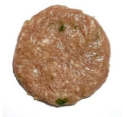 | 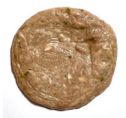 | 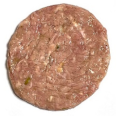 | 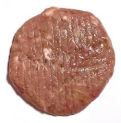 | 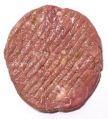 |
| After cooking | 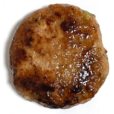 |  | 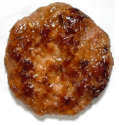 | 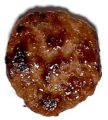 | 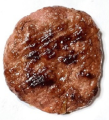 |
| Contents | Treatments 1 | |||||
|---|---|---|---|---|---|---|
| CON | REF | B1 | B2 | B3 | ||
| Before cooking | L* 2 | 60.10 ± 3.205 a56 | 52.83 ± 0.22 b | 46.75 ± 1.91 c | 41.83 ± 0.02 d | 41.55 ± 0.19 d |
| a* 3 | 6.06 ± 0.40 d | 6.24 ± 0.09 d | 9.11 ± 0.37 c | 17.29 ± 0.10 b | 19.28 ± 0.07 a | |
| b* 4 | 16.40 ± 0.81 b | 19.26 ± 0.32 a | 14.60 ± 0.70 c | 10.98 ± 0.20 d | 9.09 ± 0.23 e | |
| After cooking | L* | 61.03 ± 1.15 a | 54.30 ± 0.67 b7* | 54.48 ± 0.94 b** | 53.31 ± 2.75 b** | 51.73 ± 1.88 b** |
| a* | 6.08 ± 0.99 c | 9.84 ± 1.61 b | 11.37 ± 0.95 ab* | 13.83 ± 0.58 a** | 13.86 ± 2.10 a* | |
| b* | 15.28 ± 2.34 b | 17.21 ± 4.92 ab | 25.57 ± 6.37 a* | 14.30 ± 2.67 b | 7.59 ± 2.59 b | |
| Textural Properties | Treatments 1 | ||||
|---|---|---|---|---|---|
| CON | REF | W1 | W2 | W3 | |
| Hardness (g) | 1034.67 ± 45.002 2b | 1056.00 ± 61.22 b | 1061.67 ± 48.05 b | 1154.00 ± 57.17 ab | 1255.00 ± 91.92 a |
| Springiness (%) | 74.15 ± 0.56 a | 74.07 ± 0.51 a | 74.03 ± 0.35 a | 73.05 ± 0.42 ab | 72.63 ± 0.75 b |
| Cohesiveness (%) | 55.54 ± 0.29 3NS | 55.37 ± 0.21 | 55.02 ± 0.30 | 54.97 ± 0.38 | 54.85 ± 0.04 |
| Chewiness (g) | 958.71 ± 161.99 c | 1323.00 ± 248.92 bc | 1266.98 ± 200.40 bc | 1525.69 ± 182.39 b | 2214.10 ± 203.33 a |
| Brittleness (g) | 29,428.87 ± 111.24 a | 29,178.57 ± 149.47 a | 29,295.62 ± 90.89 a | 28,764.88 ± 127.86 b | 28,602.43 ± 62.53 b |
| Contents | Storage Days | Treatments 1 | ||||
|---|---|---|---|---|---|---|
| CON | REF | W1 | W2 | W3 | ||
| TPC (mg GAE 2/g) | 0 | 156.48 ± 0.46 4e5 | 161.19 ± 0.51 d | 165.20 ± 0.42 c | 170.14 ± 0.77 b | 184.73 ± 0.67 a |
| 7 | 143.90 ± 0.99 e6**** | 150.73 ± 1.02 d**** | 155.69 ± 0.27 c**** | 157.75 ± 0.27 b**** | 173.87 ± 0.42 a**** | |
| TFC (mg QE 3/g) | 0 | 7.86 ± 0.31 e | 10.94 ± 0.14 d | 24.88 ± 0.54 c | 32.83 ± 0.10 b | 45.46 ± 0.37 a |
| 7 | 5.42 ± 0.24 e*** | 6.68 ± 0.28 d**** | 13.84 ± 0.14 c**** | 21.69 ± 0.42 b**** | 35.63 ± 0.19 a**** | |
| Contents | Storage Days | Treatments 1 | ||||
|---|---|---|---|---|---|---|
| CON | REF | W1 | W2 | W3 | ||
| DPPH 2 radical scavenging-activities | 0 | 11.61 ± 0.93 4c5 | 16.02 ± 1.03 b | 12.49 ± 0.62 c | 12.56 ± 0.72 c | 20.36 ± 0.35 a |
| 7 | 8.28 ± 0.28 e*** | 11.16 ± 0.27 b** | 9.19 ± 0.42 d** | 10.25 ± 0.15 c** | 12.48 ± 0.15 a**** | |
| ABTS 3 radical-scavenging activities | 0 | 64.54 ± 0.54 d | 73.63 ± 0.32 c | 73.48 ± 0.31 c | 76.01 ± 0.13 b | 86.73 ± 0.31 a |
| 7 | 41.47 ± 0.27 e**** | 45.71 ± 0.46 d**** | 47.25 ± 0.19 c**** | 51.26 ± 0.55 b**** | 56.73 ± 0.22 a**** | |
| Contents | Storage Days | Treatments 1 | ||||
|---|---|---|---|---|---|---|
| CON | REF | W1 | W2 | W3 | ||
| pH | 0 | 6.03 ± 0.04 5NS6B7 | 6.06 ± 0.08 A | 6.07 ± 0.01 A | 5.97 ± 0.06 A | 5.96 ± 0.03 A |
| 7 | 6.15 ± 0.05 a8A | 5.72 ± 0.04 dB | 5.74 ± 0.02 dB | 5.89 ± 0.03 cA | 6.02 ± 0.04 bA | |
| TBARS 2 (mg malonaldehyde/kg) | 0 | 0.08 ± 0.02 aB | 0.06 ± 0.01 abB | 0.04 ± 0.01 bcB | 0.02 ± 0.01 cB | 0.02 ± 0.01 cB |
| 7 | 1.49 ± 0.01 aA | 0.22 ± 0.00 eA | 0.90 ± 0.01 bA | 0.71 ± 0.01 cA | 0.41 ± 0.01 dA | |
| VBN 3 (mg/100 g) | 0 | 10.85 ± 0.18 aB | 10.47 ± 0.03 bB | 10.54 ± 0.06 bB | 10.40 ± 0.15 bB | 10.03 ± 0.07 cB |
| 7 | 17.45 ± 0.25 aA | 14.87 ± 0.02 cA | 17.41 ± 0.08 aA | 15.42 ± 0.06 bA | 13.13 ± 0.00 dA | |
| TMC 4 (log CFU 5/g) | 0 | 5.50 ± 0.06 aB | 5.12 ± 0.02 bB | 5.17 ± 0.01 bB | 5.11 ± 0.01 bB | 5.00 ± 0.02 cB |
| 7 | 6.94 ± 0.02 aA | 6.32 ± 0.06 cA | 6.55 ± 0.03 bA | 6.34 ± 0.05 cA | 6.18 ± 0.03 dA | |
Publisher’s Note: MDPI stays neutral with regard to jurisdictional claims in published maps and institutional affiliations. |
© 2022 by the authors. Licensee MDPI, Basel, Switzerland. This article is an open access article distributed under the terms and conditions of the Creative Commons Attribution (CC BY) license (https://creativecommons.org/licenses/by/4.0/).
Share and Cite
Kim, Y.-S.; Lee, J.-J.; Kim, I.; Yu, D.; Ha, J.-H. Physicochemical and Storage Characteristics of Pork Tteokgalbi Treated with Watermelon Radish Powder. Appl. Sci. 2022, 12, 8687. https://doi.org/10.3390/app12178687
Kim Y-S, Lee J-J, Kim I, Yu D, Ha J-H. Physicochemical and Storage Characteristics of Pork Tteokgalbi Treated with Watermelon Radish Powder. Applied Sciences. 2022; 12(17):8687. https://doi.org/10.3390/app12178687
Chicago/Turabian StyleKim, Ye-Sol, Jae-Joon Lee, Inyong Kim, Daeung Yu, and Jung-Heun Ha. 2022. "Physicochemical and Storage Characteristics of Pork Tteokgalbi Treated with Watermelon Radish Powder" Applied Sciences 12, no. 17: 8687. https://doi.org/10.3390/app12178687
APA StyleKim, Y.-S., Lee, J.-J., Kim, I., Yu, D., & Ha, J.-H. (2022). Physicochemical and Storage Characteristics of Pork Tteokgalbi Treated with Watermelon Radish Powder. Applied Sciences, 12(17), 8687. https://doi.org/10.3390/app12178687







